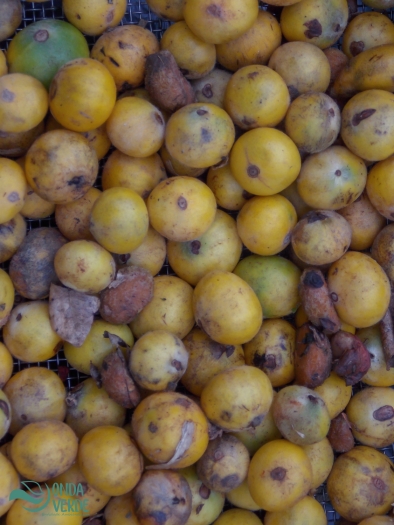Cambucá
(Plinia edulis)
Cambucá (Plinia edulis)
/
/

© Diogo Luiz
CC BY-SA 4.0
Image By:
© Diogo Luiz
Recorded By:
Copyright:
CC BY-SA 4.0
Copyright Notice:
Photo by: © Diogo Luiz | License Type: CC BY-SA 4.0 | License URL: http://creativecommons.org/licenses/by-sa/4.0/ | Uploader: diogoluiz | Publisher: iNaturalist |






Estimated Native Range
Summary
Plinia edulis, commonly known as Cambucá, is a tree native to the Atlantic Forest biome, specifically the coastal rainforests of São Paulo and Rio de Janeiro in Brazil. This species is evergreen and typically reaches up to 30 feet in height. Cambucá is characterized by its dense, rounded crown and smooth, grayish bark. The fruit is a distinctive feature, being yellowy-green, about 2 inches in diameter, with a sweet-sour flavor that combines elements of mango and papaya. The fruiting season occurs from December to March, and the fruits are quite showy due to their size and color.
Cambucá is valued for its edible fruit and is often grown in home gardens and orchards within its native range. It is also used in reforestation projects due to its adaptability to degraded areas. The tree prefers moist, well-drained soils, and although it can tolerate partial shade, it thrives in full sun. Cambucá is not widely known outside its native region but has potential as an exotic fruit crop in similar climates. It is generally low-maintenance once established but can be susceptible to pests and diseases typical of the Myrtaceae family. Propagation is usually done by seed, and germination rates are high if seeds are fresh.CC BY-SA 4.0
Cambucá is valued for its edible fruit and is often grown in home gardens and orchards within its native range. It is also used in reforestation projects due to its adaptability to degraded areas. The tree prefers moist, well-drained soils, and although it can tolerate partial shade, it thrives in full sun. Cambucá is not widely known outside its native region but has potential as an exotic fruit crop in similar climates. It is generally low-maintenance once established but can be susceptible to pests and diseases typical of the Myrtaceae family. Propagation is usually done by seed, and germination rates are high if seeds are fresh.CC BY-SA 4.0
Plant Description
- Plant Type: Tree
- Height: 12-15 feet
- Width: 8-10 feet
- Growth Rate: Moderate
- Flower Color: N/A
- Flowering Season: Spring
- Leaf Retention: Evergreen
Growth Requirements
- Sun: Full Sun, Part Shade
- Water: Medium
- Drainage: Medium
Common Uses
Edible*Disclaimer: Easyscape's listed plant edibility is for informational use. Always verify the safety and proper identification of any plant before consumption., Low Maintenance
Natural Habitat
Native to the Atlantic Forest biome, specifically the coastal rainforests of São Paulo and Rio de Janeiro
Other Names
Common Names: Cambucá-do-mato
Scientific Names: , Plinia edulis, Eugenia edulis, Marliera edulis, Marlierea edulis, Myrciaria edulis, Myrciaria plicatocostata, Plinia plicatocostata, Rubachia glomerata,
GBIF Accepted Name: